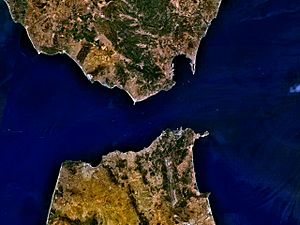Strait of Gibraltar crossing facts for kids
The Strait of Gibraltar crossing is a big idea to build a bridge or tunnel across the Strait of Gibraltar. This strait is a narrow stretch of water that connects the Atlantic Ocean to the Mediterranean Sea. It also separates the continent of Europe from Africa.
At its narrowest point, the Strait of Gibraltar is about 14 kilometers (9 miles) wide. If a crossing were built, it would connect Spain in Europe with Morocco in Africa. This project could make travel and trade between the two continents much easier.
Back in 1979, the governments of Spain and Morocco started working together to see if this idea was possible. More recently, in 2021, the United Kingdom and Morocco also talked about building a crossing between Gibraltar and Tangier.
Contents
Crossing the Strait: Bridge Ideas
Engineers have come up with different ideas for building a bridge across the Strait of Gibraltar. One idea was from Professor T.Y. Lin. He suggested a bridge between Point Oliveros and Point Cires.
This bridge would be 14 kilometers (9 miles) long. It would need very tall towers, about 3,000 feet (914 meters) high. The main section of the bridge, called the span, would be 5,000 meters (16,404 feet) long. This is more than twice as long as the longest bridge span we have today!
Another idea in 2004 came from architect Eugene Tsui. He imagined a bridge that would float on the water and also go underwater. This bridge would connect to a three-mile-wide island in the middle of the Mediterranean Sea.
Crossing the Strait: Tunnel Ideas
Many people have also suggested building a tunnel under the Strait of Gibraltar. Spain first thought about a modern tunnel way back in 1930.
Challenges of Building a Tunnel
One of the biggest problems for a tunnel is the type of rock under the Strait. Engineers found that the rock is extremely hard. This made it very difficult to dig with the tools available at the time.
Another challenge is how deep the Strait is. The shortest path is about 14 kilometers (9 miles) long. But at that point, the water can be as deep as 900 meters (2,953 feet). However, a bit further west, in an area called the Camarinal Sill, it's only about 300 meters (984 feet) deep.
The European Plate and African Plate (Earth's large land sections) meet around this area. This means the ground can be unstable.
Proposed Tunnel Route and Design
The proposed tunnel route would be about 23 kilometers (14 miles) long. It would go from west of Tarifa in Spain to the east of Tangier in Morocco. The total length of the tunnel, including connections, would likely be about 34 kilometers (21 miles).
This tunnel would probably be for trains. It would connect to Spain's high-speed railway network. A new train line is planned to be built from Cádiz to Málaga, passing through Algeciras.
Tunnel Planning and Studies
The idea for this project started with an agreement between the kings of Spain and Morocco in 1979. Because of this, a Spanish company called SECEGSA was created in 1981. Its job is to study and promote the crossing.
In 2003, Spain and Morocco agreed to look into building an underwater rail tunnel. This tunnel would link Cape Malabata near Tangier with Punta Paloma in Spain.
A Swiss company, Lombardi Engineering Ltd, was hired in 2006 to design a railway tunnel. They noted that building this tunnel would be different from the Channel Tunnel (which connects France and Great Britain). The Strait of Gibraltar is deeper, and the ground conditions are less stable.
There is an active geologic fault (a crack in the Earth's crust) called the Azores–Gibraltar Transform Fault in the Strait. This means strong earthquakes can happen there. Also, there are two deep channels of clay in the middle of the Strait. These make construction very complicated.
By 2007, there were no official costs for the project. However, earlier estimates suggested it could cost more than €5 billion.
Technical Details of the Tunnel
The proposed rail tunnel would be about 40 kilometers (25 miles) long. It would be about 300 meters (984 feet) deep. Engineers estimate it would take about 15 years to build.
An earlier plan to use the narrowest part of the Strait was dismissed. This was because the tunnel would have to be 900 meters (2,953 feet) below sea level there. For comparison, the deepest undersea tunnel right now is the Norwegian Ryfylke Tunnel, which is 291 meters (955 feet) deep. Another tunnel, Rogfast, will be deeper when finished in Norway.
Just like the Channel Tunnel has terminals for cars and trucks, the Strait of Gibraltar tunnel might also need special terminals. These would allow vehicles to be loaded onto trains to cross the Strait.
|
See also
 In Spanish: Túnel de Gibraltar para niños
In Spanish: Túnel de Gibraltar para niños



